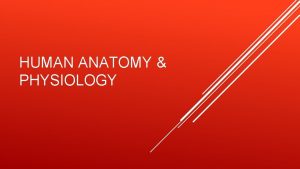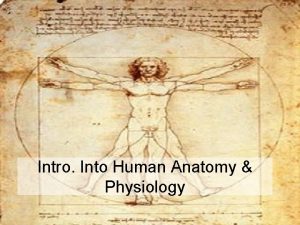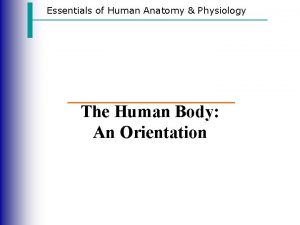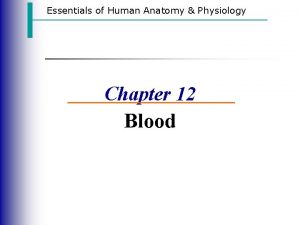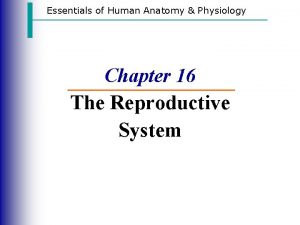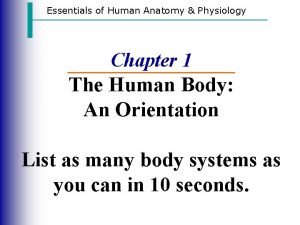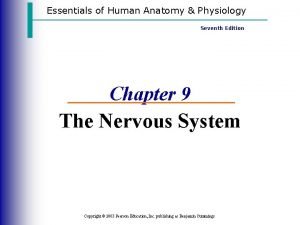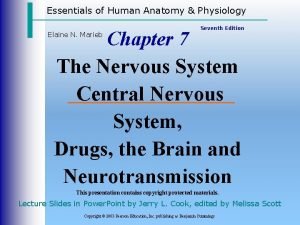Essentials of Human Anatomy Physiology Chapter 38 3













- Slides: 13

Essentials of Human Anatomy & Physiology Chapter 38 -3 The Excretory System Copyright © 2003 Pearson Education, Inc. publishing as Benjamin Cummings

QUICK REVIEW OF ELIMINATION • Lungs eliminate CO 2 • Sweat glands eliminate excess heat, salt • Digestive tract- indigestible solids, bacteria • Urinary tract is the main system of elimination

Vocabulary Hints • • Uria or Ur - urine Nephr or renal - kidney Cyst - bladder Dys - painful Cystitis - inflammation of bladder Dysuria - painful urination Hematuria - blood in urine Hydronephrosis - water in kidney

The Urinary Tract • Urinary tract consists of 2 kidneys, 2 ureters, one bladder and one urethra. • Kidney location: – Retroperitoneal – Dorsal wall of abdominal cavity – 12 th thoracic and 3 rd lumbar vertebrae • Urethra – 1. 5 inches in women, – 8 inches in men

• Kidneys filter blood- 2, 000 L/day (500 gal) – remove waste products and reabsorb water, other valuable substances. – 1. 5 L of urine/day • Metabolism produces toxic substancesnitrogen containing waste as a by-product of protein breakdown • Nitrogen eliminated as urea - water soluble

Structure of Kidney • Outer layer- Cortex • Inner layer- Medulla • Calyx- collects urine as it is formed, join together to form the ureter

• The main functional unit of the kidney is called the nephron. • 1 million per kidney • Most of nephron located in renal cortex • Loop of Henle is located in the renal medulla


• Capillaries in glomerulus filter blood- Bowman’ capsule collects ultra filtrate • Through passive and active diffusion, 95% of water is reabsorbed, along with K, Na, Ca • Other things are actively excreted, like drugs. • Excretion is controlled by hormones such as ADH from hypothalamus

Urine is made in 4 steps 1. Filtration 2. Reabsorption 3. Secretion 4. Excretion A urinalysis is the most common non-invasive medical test ordered

Diseases of the Kidney • Acute Kidney failure– Causes: nephritis, shock, injury, heart failure or poisoning – Symptoms: anuria or oliguria. Uremia, nausea, coma, death • Chronic Kidney failure– gradual loss of function due to hypertension (high blood pressure) or endocrine disease Causes: nephritis, shock, injury, heart failure or poisoning – Symptoms: anuria or oliguria. Uremia, nausea, coma, death • Cystitis- inflammation of the urinary bladder

Kidney Dialysis

Dialysis, Kidney transplant • Hemodialysis- serves as an “artificial kidney” 2 -3 times per week for 2 -4 hours • Peritoneal dialysis- uses patient’s own peritoneal lining to filter blood • Kidney transplant- need suitable donor. Only need one, but must take antirejection drugs for the life of the patient
 Waistline
Waistline Chapter 1 introduction to anatomy and physiology
Chapter 1 introduction to anatomy and physiology Chapter 2 human reproductive anatomy and physiology
Chapter 2 human reproductive anatomy and physiology 3 layers of muscle
3 layers of muscle Holes essential of human anatomy and physiology
Holes essential of human anatomy and physiology Human anatomy and physiology 10th edition
Human anatomy and physiology 10th edition Human anatomy & physiology edition 9
Human anatomy & physiology edition 9 The central sulcus divides which two lobes? (figure 14-13)
The central sulcus divides which two lobes? (figure 14-13) Anatomy and physiology chapter 8 special senses
Anatomy and physiology chapter 8 special senses Chapter 13 anatomy and physiology of pregnancy
Chapter 13 anatomy and physiology of pregnancy Chapter 2 basic chemistry anatomy and physiology
Chapter 2 basic chemistry anatomy and physiology Heat and cold
Heat and cold Anatomy and physiology coloring workbook figure 14-1
Anatomy and physiology coloring workbook figure 14-1 Chapter 10 blood anatomy and physiology
Chapter 10 blood anatomy and physiology
















